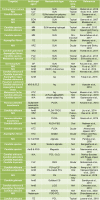Current applications and prospects of nanoparticles for antifungal drug delivery
- PMID: 33883983
- PMCID: PMC8056051
- DOI: 10.17179/excli2020-3068
Current applications and prospects of nanoparticles for antifungal drug delivery
Abstract
Currently, the significance of fungi as human pathogens is not medically concealed in the world. Consequently, suitable recognition and treatment of such infections are of great importance and necessitate the need for comprehensive information in this regard. The introduction of new antifungals and their use today, especially in the last two decades, have revolutionized the treatment of fungal infections. On the other hand, increasing drug resistance in the world has overshadowed such developments. The use of NPs results in the treatment of fungal infections and owing to their specific properties, these particles, unlike the pure antibiotics, can exert a greater inhibitory power although with less concentration compared with conventional drugs. Important reasons that have led to the use of antifungal drugs in delivery systems include reduced drug efficacy, limited penetration through tissue, poor aqueous solubility, decreased bioavailability, and poor drug pharmacokinetics. It is therefore hoped that unfavorable properties of antifungal drugs be mitigated via their incorporation into different types of NPs. This review summarizes the different types of NPs as delivery systems of antifungal as well as their advantages over pure drugs.
Keywords: antifungal drug; drug delivery; nanoparticles.
Copyright © 2021 Nami et al.
Figures




Similar articles
-
Nanotherapeutics for the delivery of antifungal drugs.Ther Deliv. 2024 Jan 4. doi: 10.4155/tde-2023-0090. Online ahead of print. Ther Deliv. 2024. PMID: 38174574 Review.
-
Nanoparticles as safe and effective delivery systems of antifungal agents: Achievements and challenges.Int J Pharm. 2017 May 15;523(1):15-32. doi: 10.1016/j.ijpharm.2017.03.019. Epub 2017 Mar 19. Int J Pharm. 2017. PMID: 28323096 Review.
-
Potential Use of Alginate-Based Carriers As Antifungal Delivery System.Front Microbiol. 2017 Jan 30;8:97. doi: 10.3389/fmicb.2017.00097. eCollection 2017. Front Microbiol. 2017. PMID: 28194145 Free PMC article. Review.
-
[Development of antituberculous drugs: current status and future prospects].Kekkaku. 2006 Dec;81(12):753-74. Kekkaku. 2006. PMID: 17240921 Review. Japanese.
-
Candida and candidaemia. Susceptibility and epidemiology.Dan Med J. 2013 Nov;60(11):B4698. Dan Med J. 2013. PMID: 24192246 Review.
Cited by
-
New Therapeutic Options for Fusariosis: A Patent Review (2008-2023).J Fungi (Basel). 2025 Jun 18;11(6):463. doi: 10.3390/jof11060463. J Fungi (Basel). 2025. PMID: 40558974 Free PMC article.
-
Regulation of Ergosterol Biosynthesis in Pathogenic Fungi: Opportunities for Therapeutic Development.Microorganisms. 2025 Apr 10;13(4):862. doi: 10.3390/microorganisms13040862. Microorganisms. 2025. PMID: 40284698 Free PMC article. Review.
-
Emerging Polymer-Based Nanosystem Strategies in the Delivery of Antifungal Drugs.Pharmaceutics. 2023 Jul 1;15(7):1866. doi: 10.3390/pharmaceutics15071866. Pharmaceutics. 2023. PMID: 37514052 Free PMC article. Review.
-
Silencing of HMGA2 by siRNA Loaded Methotrexate Functionalized Polyamidoamine Dendrimer for Human Breast Cancer Cell Therapy.Genes (Basel). 2021 Jul 20;12(7):1102. doi: 10.3390/genes12071102. Genes (Basel). 2021. PMID: 34356120 Free PMC article.
-
Perspectives and Prospective on Solid Lipid Nanoparticles as Drug Delivery Systems.Molecules. 2022 Feb 24;27(5):1543. doi: 10.3390/molecules27051543. Molecules. 2022. PMID: 35268643 Free PMC article. Review.
References
-
- Aghebati‐Maleki A, Dolati S, Ahmadi M, Baghbanzhadeh A, Asadi M, Fotouhi A, et al. Nanoparticles and cancer therapy: Perspectives for application of nanoparticles in the treatment of cancers. J Cell Physiol. 2020;235:1962–1972. - PubMed
-
- Ahmad A, Wei Y, Syed F, Tahir K, Taj R, Khan AU, et al. Amphotericin B-conjugated biogenic silver nanoparticles as an innovative strategy for fungal infections. Microb Pathog. 2016;99:271–81. - PubMed
-
- Ahsan SM, Rao CM. Condition responsive nanoparticles for managing infection and inflammation in keratitis. Nanoscale. 2017;9:9946–59. - PubMed
Publication types
LinkOut - more resources
Full Text Sources
